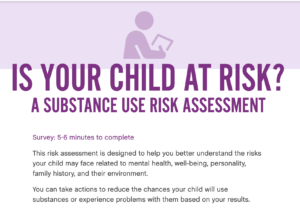Risk tool developed by Kaiser Permanente team based on medical records of children, mothers
Parents are sometimes shocked to learn that their teenager has a drinking or drug problem. But an analysis by Kaiser Permanente researchers suggests there may be clues in a child’s medical history, and they’ve used that research and input from parents to develop a free online tool that anyone can use to predict the risk of a child’s substance use problem.
 The online quiz is on the website of the Partnership to End Addiction, the non-profit organization that collaborated with a team led by Stacy Sterling, DrPH, MSW, a research scientist at the Kaiser Permanente Division of Research and co-director of its Center for Addiction and Mental Health Research.
The online quiz is on the website of the Partnership to End Addiction, the non-profit organization that collaborated with a team led by Stacy Sterling, DrPH, MSW, a research scientist at the Kaiser Permanente Division of Research and co-director of its Center for Addiction and Mental Health Research.
“This tool is meant to help parents and clinicians more reliably predict when a child is at risk for a future substance use problem, so they can intervene with preventive measures and early treatment when needed,” Sterling said. “Clinicians’ ability to make predictions has been limited to anecdotal evidence and best-guesses, and research has shown those methods don’t work well. We’re hoping this tool can be a step toward a more evidence-based approach to substance use-related risk reduction for young people.”

The Partnership’s goal is to help parents who may have trouble assessing how seriously to take a young teenager’s experimentation with drugs or alcohol. “Parents told us they were suddenly finding out their teen was getting high on weekends — something the parents themselves may have done when they were younger without suffering severe negative consequences,” said Partnership Senior Advisor Sean Clarkin. “So they want to know how worried they should be about their kid’s ‘experimentation.’ And there are answers to that question, because of this study and others that identify the risk factors.”
These include: ongoing mental health problems, impulsivity, risk-taking, a family history of addiction, family conflict, spending time with peers who are using, early use of substances, or having sustained trouble in school.
Machine learning to predict risk
The study underpinning the tool was published in the Journal of Substance Abuse Treatment and involved an analysis of medical records for 41,000 adolescents born between 1997 and 2000, and their mothers, who were patients at 4 health systems: Kaiser Permanente Northern California (KPNC), Kaiser Permanente Hawaii, Geisinger Clinic in Pennsylvania, and Henry Ford Health System in Detroit.
The researchers included analyst and lead author Felicia Chi, MPH, and biostatistician Stacey Alexeeff, PhD, of the Division of Research, along with researchers from the three other participating health systems. They developed a risk model using multiple elements from the childhood medical records of the children and their mothers and applied a sophisticated data technique known as machine learning to determine which factors during childhood and adolescence predicted a diagnosis of a drug or alcohol problem as a teen.
We are really trying to normalize prevention of substance use problems like any other health concern.
—Stacy Sterling, DrPH, MSW
The medical records showed 3.4% of the adolescents had a diagnosed alcohol or drug problem between ages 12 and 18. The study found certain factors prior to age 12 were strong predictors of substance use problems during adolescence. Children of mothers with a substance use problem were 1.5 to 2.5 times more likely to have one themselves. Children with an oppositional defiance diagnosis were twice as likely to develop a substance use problem later. Other risk factors included diagnosis of a trauma or stress-related disorder, ADHD, headache, conduct disorders or self-injury. Meanwhile, children with an autism diagnosis were less likely to develop a substance use problem.
The study also identified risk factors which, even if they emerged only after age 12 also conferred risk of substance use problems, such as ADHD, bipolar disorder, depression, eating disorders, oppositional defiant disorder, headache, trauma, and self-harm.
The researchers noted the strong relationship between maternal substance use and mental health diagnoses and those of their children. “The findings underscore the need for robust perinatal and early childhood screening and support interventions, and for parenting programs in pediatric primary care,” the authors wrote.
Evidence-based assistance for parents
The authors also suggested the results could be translated into a format that is helpful for parents. Enter the Partnership to End Addiction. Using funding from Sterling’s grant from the Conrad Hilton Foundation, the non-profit built a risk assessment prediction tool for parents and clinicians, informed by the researchers’ predictive model. Previous questionnaires meant to help parents were largely designed with good intentions and educated guesses, but not peer-reviewed evidence from research, the Partnership’s Clarkin said.

“The Kaiser Permanente data just adds another dimension of statistical strength and predictive power,” he said. “This was particularly important to the pediatricians we talked with. They weren’t going to be receptive to something that was just thrown together.”
The research findings were used to inform the topics of the tool’s questions, which were designed to be understandable and useful to parents. Focus groups of parents and pediatricians provided feedback on different types of messaging and formats. Topics that might be difficult to answer — because a parent might not have enough information about their child’s activities — were not included, to avoid frustrating users.
Upon completion, the user gets an assessment of the child’s risk of a substance use disorder along with resources for next steps and how to get help. Clinicians can refer parents to use the quiz and resources.
Sterling’s team worked with the Partnership to develop materials for parents, called playbooks, that are available online and provide education and assistance for working with a child with a developing drug or alcohol problem. There is a playbook for parents of tweens and another for parents of teens.
“There’s a big gap between having ‘the drug talk’ and putting your child in treatment,” explained Pat Aussem, associate vice president of consumer clinical content development for the Partnership. “We developed an online e-learning program that explains why kids use substances in the first place, and offers skills parents can use to have conversations about difficult subjects and encourage healthier behaviors.”

The Partnership is carrying out a campaign to educate both clinicians and parents about the materials to reach adolescents at risk.
Sterling sees the effort as similar to other preventive medicine campaigns meant to help people identify a problem early, such as monitoring a child’s skin for sun damage to avoid skin cancer later. “This health condition, substance use, remains stigmatized — the idea that they are ‘bad kids,’” she said. “We are really trying to change that and normalize prevention of substance use problems like any other health concern. We want to arm all of us — parents, patients, clinicians — with some additional information to protect our kids and nurture healthy development.”
# # #
About the Kaiser Permanente Division of Research
The Kaiser Permanente Division of Research conducts, publishes and disseminates epidemiologic and health services research to improve the health and medical care of Kaiser Permanente members and society at large. It seeks to understand the determinants of illness and well-being, and to improve the quality and cost-effectiveness of health care. Currently, DOR’s 600-plus staff is working on more than 450 epidemiological and health services research projects. For more information, visit divisionofresearch.kaiserpermanente.org or follow us @KPDOR.





This Post Has 0 Comments